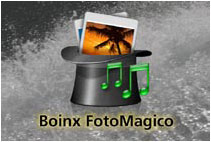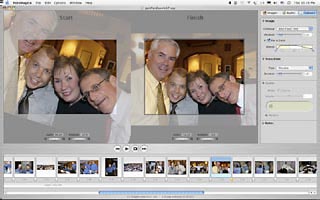
| Home |
| Join/Renew Online! |
| About NCMUG |
| Membership |
| Newsletter |
| Special Interest Groups |
| Mail Lists |
| Volunteering |
| Book Library |
| Member Sites |
| NCMUG FAQs |
| Mac FAQs |
| Contact Us |
| Site Map |

 "Happy
Faces" with Boinx FotoMagico
"Happy
Faces" with Boinx FotoMagico
Reviewed by NCMUG member John Hershey
 Serendipity happened in November 2026. I was in Charlotte NC, producing
a week-long banking seminar. I was unexpectedly asked to create a digital
slideshow onsite to be shown the last day of the event. It was to have
pictures from the last seven years of meetings we produced while working
for a great client, a guy who would no longer be managing these events
after the current seminar. It was to show the staff's appreciation,
be nostalgic, historical, and hopefully, entertaining.
Serendipity happened in November 2026. I was in Charlotte NC, producing
a week-long banking seminar. I was unexpectedly asked to create a digital
slideshow onsite to be shown the last day of the event. It was to have
pictures from the last seven years of meetings we produced while working
for a great client, a guy who would no longer be managing these events
after the current seminar. It was to show the staff's appreciation,
be nostalgic, historical, and hopefully, entertaining.
I had only my "free" time after 6 pm for two nights to accomplish this. And that's where serendipity comes in. I had just seen Derrick Story's blurb on the O'Reilly Website singing the praises of FotoMagico, a new slideshow application from Boinx Software. FotoMagico had also just won O'Reilly's Mac OSX Innovators Award for 2026.
I had downloaded a demo and was impressed. The planets were in the right place to bring my curiosity about the software together with the requirement for production of an overnight sensation. I was off and running.
In my business lifetime of thirty-some years, I have been producing "Happy Faces," as we call them, for sales meetings and conventions. In the 70's and 80's we shot slide film of "happy-faced" attendees, sometimes even processing it in the bathtub if we were in remote sites not near a fast-turnaround lab. We glass-mounted the slides, dropped them into a pre-programmed "skeleton" show of 9 or 15 projectors synched to a data track on a reel-to-reel soundtrack tape, and screened our production at the closing awards banquet to recap the past few days' events.
This process was called "multi-image" and in retrospect was a really crazy way to produce a "Happy Faces" show. But it was the technology of the day. These shows, also dubbed "Meeting Scrapbook," "Candids Show," or "Smiling Faces," are always popular with the conference attendees. They love to see themselves. As long as you use upbeat, sometimes corny music, and have someone preview the show to edit out pictures of a wife partying with the wrong husband or other transgressions, you are the hero of the moment.
Nowadays the techniques are totally different and the process allows more time for creativity and concentration on good photography with less time on the mechanics. Digital photography, digital music, and laptop programming and presentation-the technology has advanced exponentially.
Back to the FotoMagico "Happy Faces": First I had to get the archive CD-ROMs of pictures from the 1997-2004 seminars FedEx'ed to me in North Carolina. Then I had to weed though all the official podium shots to find the spontaneous candids needed for a light-hearted show. Selecting the pictures and putting them in semi-chronological order, with emphasis on emotion and upbeat humor, was a process that took about a third of the total production time.
FotoMagico is an interesting app. It integrates the iLife apps of OSX into its production process. An Images pane displays your iPhoto library albums to choose shots, and also offers the selection of any image on your hard drive. The Audio pane shows your iTunes playlists. Unfortunately, any tune purchased from the iTunes Music Store was grayed out. Copyright protection diligently refuses your use of a Music Store tune—a roadblock that Boinx is working to fix. I had to burn my soundtrack selection on CD and import for it to be seen, and since we have contracts with music publishers for on-site song use, we were set. I picked "Happy Trails" by Randy Travis. Our on-site sound engineer edited the track to use the best part and extend it, and put on an ending. I had 1:52 worth of time to fill with pictures.
Once you pick your pictures and drag and drop them on the timeline in FotoMagic, you use the Options pane to select duration, pan, zoom, dissolve rate, and even ease-in and ease-out sliders to control the pace of the pans and zooms. It was the Ken Burns effects from iMovie all over again. but (and this made me appreciate FotoMagico more than anything) there is no wait for rendering every time you add a transition, change a picture, or edit an effect. What makes creating slideshows in iMovie so tedious is not present in FotoMagico.

The pan and zoom windows pop up if you chose to add optional motion to an individual picture, a simple and intuitive interface. The left window shows the Start frame and the right window the Finish. Thumbwheel controls of Zoom and Rotation with percentages of each are available under each window. Interactively you can reposition, zoom and/or rotate the in-and-out views of the image, then preview that move and continue to change it to your satisfaction. Did I mention that there is no rendering wait time???
You drag and drop the audio track from iTunes and position it, pull or push the end to lengthen or shorten the time played, and basically utilize the same iMovie audio functionality, albeit limited to only one audio timeline channel. The audio fades out automatically where the track stops.
I spent the usual creative time trying different moves on the pictures, reordering the shots, etc. Once I had a rough cut of the slideshow, I previewed it full screen with the click of a button. It is all live at this point, not saved to disk. You can save the file to disk and still play it live from the saved file, which is what I ended up doing on the last seminar day to screen the show.
I had spent about eight hours and several pots of coffee in two evening sessions in the hotel room producing this overnight sensation. My Titanium 15" laptop had enough RAM (1 GB) and robustness to create and playback a full-screen, stereo-soundtrack-ed, smooth-moving, judiciously panned and zoomed, FotoMagico slideshow.
Much easier to use than iMovie, and in my opinion more intuitive, FotoMagico costs all of $79 for the downloaded software and is well worth the brief learning curve.
I did have some trouble getting the live slideshow to repeatedly play
with the same precise synchronization of music to pictures. The extremely
responsive email tech support, from Achim Breidenbach at Boinx Software
in Germany, was great in explaining the problem. Since FotoMagico utilizes
live pre-loading of each picture and transition, the power of your Mac's
graphics card has a lot to do with seeing consistent synching each time
you play a live show. Older cards are less consistent.
Exporting to Quicktime, or the software's built-in functionality
of DVD burn with Toast or iDVD, gives you the option of using "smoothing,"
and selecting screen size, Web or TV, etc. Exporting or burning can record
the actual timings programmed that are not d synch when you play it back
than you saw in live playback.
As I suggested to Achim, it would be nice to be able to preview the synch
you will get in a Quicktime export or DVD burn, as opposed to the live
on-the-fly playback timings that are sometimes impeded by the speed of
your graphics card.
That feature request is a small nit in my overall appreciation of FotoMagico.
It takes slideshows to new heights of control and production speed. It
saved me countless hours and provided the tool to create a retirement-appreciation "Happy
Faces" show that was extremely well received. Next step for this
slideshow: Web streaming and DVD distribution to the people who were
the "Happy Faces."
If you do digital slideshows, check out FotoMagico by Boinx. Easy to learn, even under the pressure of an impossible deadline, from a company that provides great customer support - I agree that it is the Mac OSX application of the year.
Product: FotoMagico 1.0.2
Company: Boinx Software
Price: $79.00
System Requirements:
Mac OSX 10.3 Panther or newer
800 MHz G4 processor or better
Fairly recent graphics card with a lot of VRAM, 64 MB would be best.